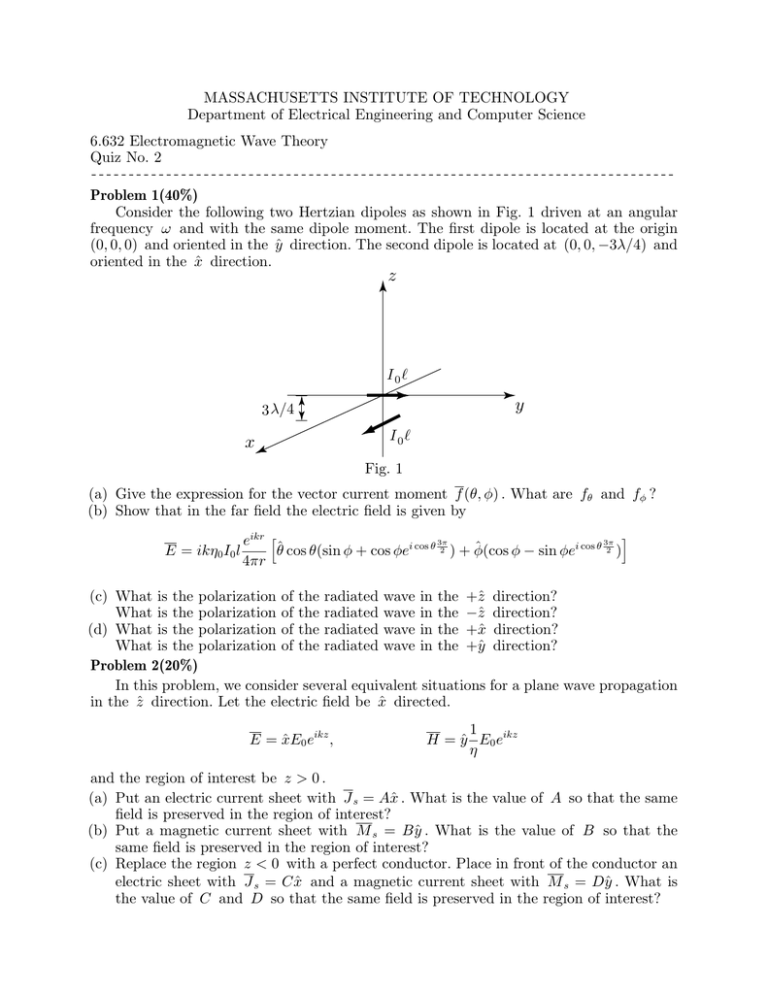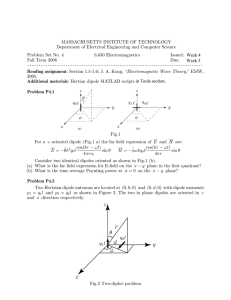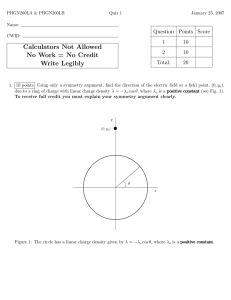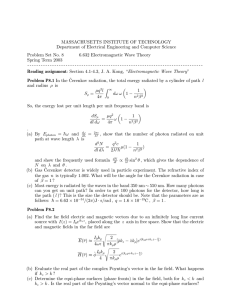MASSACHUSETTS INSTITUTE OF TECHNOLOGY Department of Electrical Engineering and Computer Science
advertisement

MASSACHUSETTS INSTITUTE OF TECHNOLOGY Department of Electrical Engineering and Computer Science 6.632 Electromagnetic Wave Theory Quiz No. 2 -----------------------------------------------------------------------------Problem 1(40%) Consider the following two Hertzian dipoles as shown in Fig. 1 driven at an angular frequency ω and with the same dipole moment. The first dipole is located at the origin (0, 0, 0) and oriented in the ŷ direction. The second dipole is located at (0, 0, −3λ/4) and oriented in the x̂ direction. z I 0 y 3 λ/4 x I 0 Fig. 1 (a) Give the expression for the vector current moment f (θ, φ) . What are fθ and fφ ? (b) Show that in the far field the electric field is given by E = ikη0 I0 l 3π 3π eikr ˆ ˆ θ cos θ(sin φ + cos φei cos θ 2 ) + φ(cos φ − sin φei cos θ 2 ) 4πr (c) What is the polarization of the radiated wave in the +ẑ direction? What is the polarization of the radiated wave in the −ẑ direction? (d) What is the polarization of the radiated wave in the +x̂ direction? What is the polarization of the radiated wave in the +ŷ direction? Problem 2(20%) In this problem, we consider several equivalent situations for a plane wave propagation in the ẑ direction. Let the electric field be x̂ directed. E = xE ˆ 0 eikz , 1 H = yˆ E0 eikz η and the region of interest be z > 0 . (a) Put an electric current sheet with J s = Ax̂ . What is the value of A so that the same field is preserved in the region of interest? (b) Put a magnetic current sheet with M s = Bŷ . What is the value of B so that the same field is preserved in the region of interest? (c) Replace the region z < 0 with a perfect conductor. Place in front of the conductor an electric sheet with J s = C x̂ and a magnetic current sheet with M s = Dŷ . What is the value of C and D so that the same field is preserved in the region of interest? Problem 3(40%) An electric dipole antenna with dipole moment I is oriented in the ẑ direction and is placed in the front of perfectly conducting wall as shown in the Fig. 2a. The wall is located at x = 0 and extends to infinity in both y and z directions. The dipole is located at (d, 0, 0) , where d = λ/4 . z z r̄ r̄ I I σ→∞ σ→∞ θ θ x y x y d d Fig. 2a Fig. 2b (a) Consider the case where the wall is removed in Fig. 2a. Plot the radiation pattern of the electric field |E| in the xz plane. Plot the radiation pattern of the electric field |E| in the xy plane. (b) The wall is still there as shown in the Fig. 2a. Plot the radiation pattern of the electric field |E| in the xz plane. In part (c), (d), (e), the dipole is oriented in x direction as shown in Fig. 2b. (c) Consider the case where the wall is removed in Fig. 2b. Plot the radiation pattern of the electric field |E| in the xz plane. (d) The wall is still there as shown in Fig. 2b. Plot the radiation pattern of the electric field |E| in the xz plane. (e) If the dipole is located at d = 5λ/4 , give all the values of θ ( 0 ≤ θ ≤ π/2 ) at which the null occurs for the far field.







